The employment practices for which Japanese business gained fame—and later notoriety—are alive and well according to economist Ry o Kambayashi, who uses statistical analysis to challenge some widespread assumptions about the Japanese labor market.
* * *
1. Introduction
Once hailed for their flexibility and economic rationality, the Japanese Employment System in the post–World War II era came under attack in the 1990s as a cause of economic stagnation. Opinion leaders began publicly advocating an overhaul of the legal and social institutions supporting Japan’s labor market, and virtually every government or think-tank report dealing with labor and employment gave lip service to the idea of labor market reform.
Two decades on, it is difficult to point to any clear signs of progress. In recent years commentators have begun using the discouraging term “bedrock regulations” in reference to labor laws and regulations that have resisted reform due to the political influence of vested interests. But this interpretation assumes the existence of regulators and rules that are deliberately blocking change in the labor market. Instead, I would suggest that the Japanese labor market is not subject to any particular decision-making entity but an accumulated result of local agreements among multiple stakeholders.
In this paper I highlight the persistence of certain self-sustaining Japanese employment practices, despite regulatory reforms, summarizing two recent studies that I carried out in collaboration with a colleague. After providing an overview of the labor market since the 1990s in section 2, I turn my attention in section 3 to trends in long-term employment, the mainstay of the Japanese Employment System, calling into question the widespread assumption that long-term employment is in a steep decline in Japan.
But how can long-term employment be alive and well, given the off-cited rise in Japanese companies’ use of ” nonstandard” employees? In section 4, citing the decline in the number of workers classified as “self-employed and others,” I explain why the increase in nonstandard employment is not synonymous with a decline in long-term employment. In section 5, I assess the persistence of another key feature of the Japanese Employment System, seniority-based wages. And in section 6, I conclude with a discussion of the deeply rooted Japanese tradition of local collective agreements as a key factor underlying the persistence of such practices.
2. Overview of the Labor Market since the 1990 s
Let us start by looking at basic trends in the Japanese labor market over the past two decades or so, beginning with the unemployment rate. Figure 1 is based on unemployment figures compiled by the Organization for Economic Cooperation and Development, which are adjusted to enable a valid international comparison. To illuminate long-term trends, I have included figures going back to the 1950s. The shaded section represents the period following the collapse of Japan’s asset bubble in 1992.
Figure 1. Unemployment Rate as a Percentage of the Civilian Labor Force by Country, 1956–2010
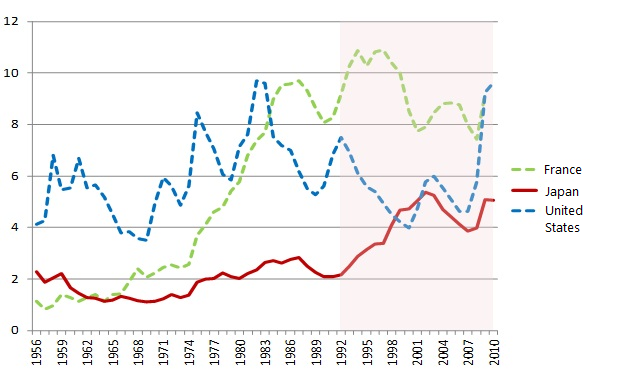
As the graph indicates, Japan’s unemployment rate remained consistently low until the collapse of the bubble economy in 1992. After that, we see a marked upward trajectory that continues until 2002. The situation improved thereafter until the global recession precipitated by the 2007–8 financial crisis, at which point unemployment surged once again.
Still, while Japan experienced a marked rise in joblessness over the past two decades, it enjoyed both a lower rate of unemployment overall and far less dramatic fluctuation than the other major OECD countries. This suggests a disconnect between the performance of the Japanese labor market in an international context and the perception of that market within Japan.
This disconnect was particularly marked during the global recession. The graph below, also compiled from OECD figures, charts the shock caused by the financial crisis in the major OECD countries (as changes in real gross domestic product) and the reaction of the labor market to the crash (as changes in the unemployment rate).
Figure 2. Impact of the Global Recession on GDP and Unemployment in Selected OECD Countries (change from peak to trough)
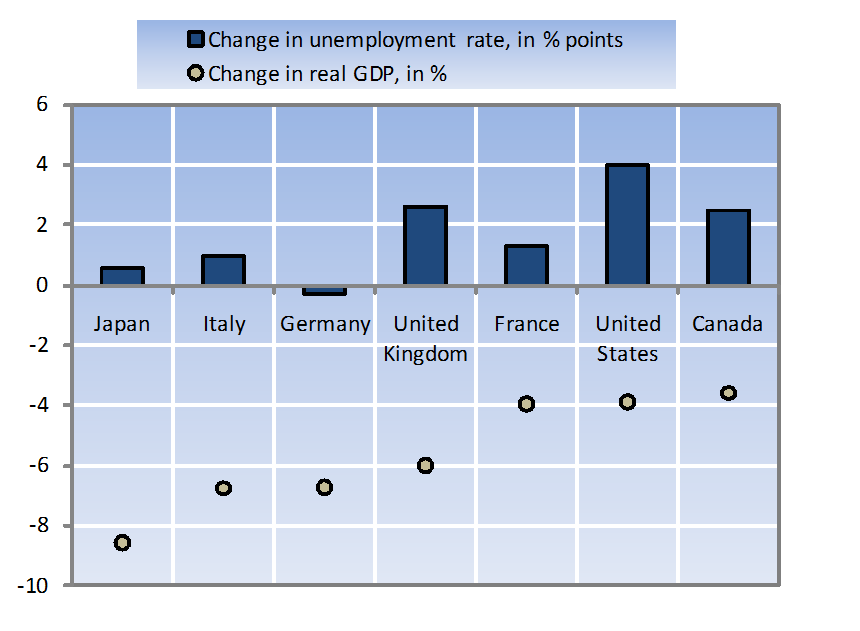
Source: OECD, Main Economic Indicators Database.
In terms of GDP, the financial crisis and ensuing recession had a greater impact on Japan than on Britain, France, Germany, Italy, or the United States. Yet the increase in unemployment was relatively small. In other words, while Japan experienced a bigger economic contraction than any of the other countries, the labor market was somehow cushioned from direct impact. This kind of cushion calls to mind one of the well-known mechanisms of the Japanese Employment System, in which companies rely on adjustments in pay and working hours, rather than workforce cuts, to adapt to business slowdowns. It suggests that, even in the face of the worst recession in a hundred years, this aspect of the Japanese labor market remained fundamentally unchanged.
3. The State of Long-Term Employment
This survey of the Japanese labor market through the fundamental macroeconomic lens of unemployment should be enough to call into question the widely held belief that the market has changed fundamentally since the 1990s. But it is not the only evidence contradicting that assumption. In 2012 Takao Kato and I published a working paper analyzing trends in long-term employment among Japanese companies. Using data from the Japanese government’s Employment Status Survey and the US government’s Current Population Survey, we calculated the percentage of workers in various groups who remained with the same company for 10 years or more in both countries and called into question the assumption that long-term employment is declining in Japan.
Figure 3 charts the change in the 10-year job retention rate for core company employees, defined as employees aged 30–44 with at least five years’ tenure at the start of the observation period. We see that in Japan, more than 70% of employees aged 30–34 with five years’ tenure as of 1982 were working at the same company 10 years later, in 1992. In the United States, the corresponding figure was just over 50%. At a glance we can see that the 10-year retention rate is much higher in Japan than the United States across the board, an indication of the value the Japanese place on long-term employment.
More surprisingly, the graph reveals that the trend away from long-term employment is considerably more pronounced in the United States than in Japan. In fact, during this time, Japan has seen little change in the 10-year retention rate for those employees traditionally regarded as the core of a company’s workforce.
Figure 3. Change in 10-Year Job Retention Rate for Employees with 5+ Years Initial Tenure, Japan and United States
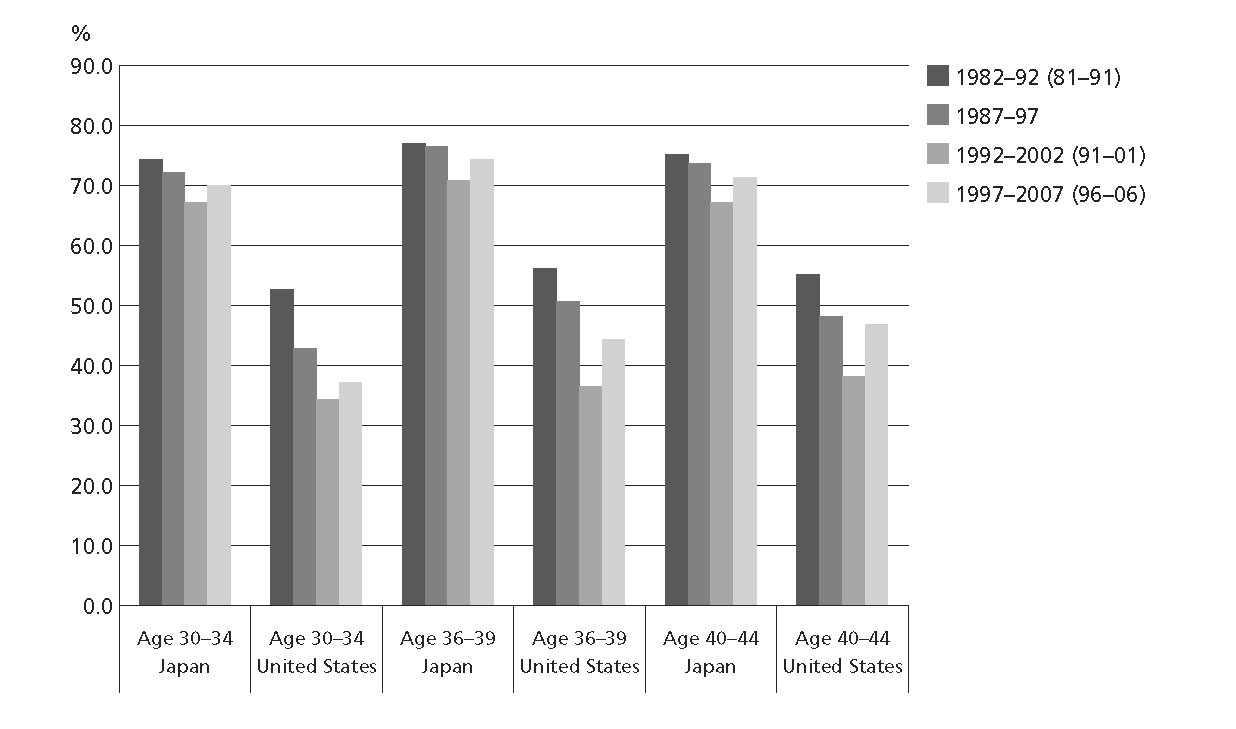
Of course, there is more to long-term employment than core employees. Figure 4 tracks the changes in the 10-year retention rate among employees with less than five years’ initial tenure, that is, mid-career hires and younger employees. The 10-year job retention rate for mid-career hires has fallen continuously in Japan, whereas the United States has registered little change overall. Likewise, the rate for young workers has fallen steadily Japan. (One should note, however, that the extremely low 10-year retention rate for US workers in their twenties—in the vicinity of 10%—raises questions of statistical reliability.)
Figure 4. Change in 10-Year Retention Rate for Employees with Less than 5 Years’ Initial Tenure, Japan and United States
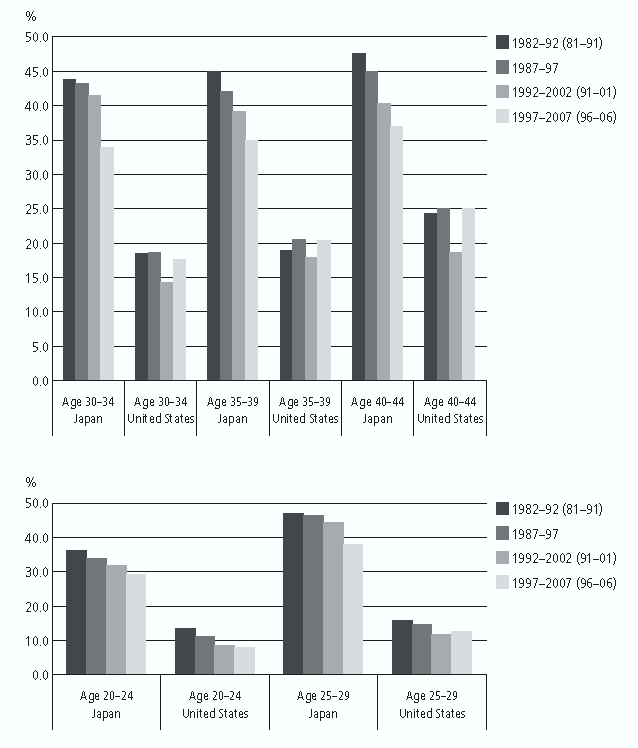
The 10-year retention rate does not distinguish between demand-side and supply-side factors—that is, it lumps those who are dismissed or laid off with those who leave of their own volition. Consequently, it is possible that increases in voluntary attrition in the United States could create the appearance of a decline in long-term employment as a managerial practice. In Kambayashi and Kato (2012), we approached the issue from an alternative angle, tracking and comparing the correlation between years of service and the risk of job loss. Our findings are summed up in Figure 5.
Figure 5. Predicted Job Loss Rate and Tenure in Japan and United States, 1997 and 2007
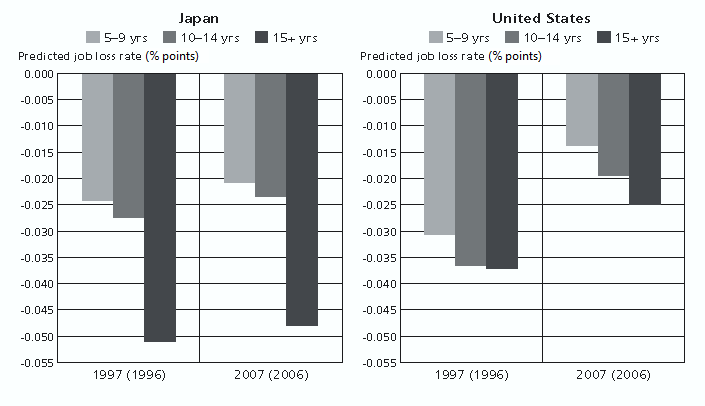
In 1997, the probability of losing one’s job in Japan was 5 percentage points lower among company veterans with 15 years or more of service than among recent hires; in the United States, the difference was 3.5 percentage points. In other words, veterans enjoyed substantially greater job stability in both Japan and the United States. In Japan, the picture remains essentially the same a decade later, while in the United States the risk of losing one’s job has increased across the board, although years of service provided somewhat greater protection. Taken together with Figure 3, this analysis confirms that it is not Japan but the United States that has experienced a significant decline in long-term employment security.
In short, our comparison revealed that, since the 1980s, job security among core employees has declined in the United States but not in Japan. The only groups that could be experiencing greater job instability in Japan are mid-career hires and younger employees.
4. Understanding the Rise in Nonregular Employment
The assertion that long-term employment has not, in fact, fallen out of favor among Japanese companies may seem to fly in the face of conventional wisdom, given the well-documented rise in “nonstandard” employment ( hiseiki koyo ). It is perhaps natural to assume that the rise in nonstandard employment signifies a decline in the practice of long-term employment. But if the conclusions presented in the previous section are correct, then that assumption must be wrong.
We took up this issue in another paper, published as a working paper in 2013. We began by attempting to determine the forms of employment that are recognized as nonstandard employment in the Japanese labor market. Nonstandard employment is defined in a number of ways, but the criterion one encounters most often is whether or not the employee is hired under a fixed-term contract.
Under Japanese labor law, the distinction between fixed-term and indefinite (that is, permanent) employment is all-important. Likewise, the OECD, in calling for an end to the disparity in regulations governing the dismissal of regular and nonregular employees, defines nonregular employees as those with fixed-term contracts and regular employees as those with indefinite contracts; in Europe there is really no other definition of nonregular employment. In Japan, however, studies of human resource management and labor relations have traditionally placed more emphasis on workers’ job titles than on the distinction between fixed-term and indefinite contracts.
In our 2013 paper, we conducted a statistical analysis to determine whether the employees’ titles or the term of the labor contract correlated more strongly with such key indicators of the Japanese Employment System as separation risk, wages, and participation in company-sponsored training programs. We found that the designation was the decisive factor. In other words, employees with the same titles were treated virtually the same with respect to the aforementioned indicators, regardless of whether they were working under indefinite or fixed-term contracts.
This finding highlights the limited power of statutory laws and regulations in Japan’s labor market. In Japan, textbook discussions as well as case law concerning abusive dismissals and the legality of employee layoffs all focus first and foremost on whether the labor contract is fixed or indefinite. The employee’s designation within the workplace is never mentioned. From a legal standpoint, therefore, the term of the contract is all-important, and the workplace designation of the employee’s post or job classification is beside the point. Yet that designation—not the term of the contract—is crucial in determining whether an employee is considered part of the company’s core workforce and is therefore subject to the basic benefits and requirements associated with the Japanese Employment System. This suggests that many Japanese employment practices have a life of their own, independent of statutory laws and regulations.
With these findings in mind, our study charted the change in the number of nonstandard employees in Japan since the 1980s, dividing these employees into four groups based on employee designation and whether they were on fixed-term contracts or working under indefinite contracts.
Figure 6. Composition of Labor Force by Type of Employment
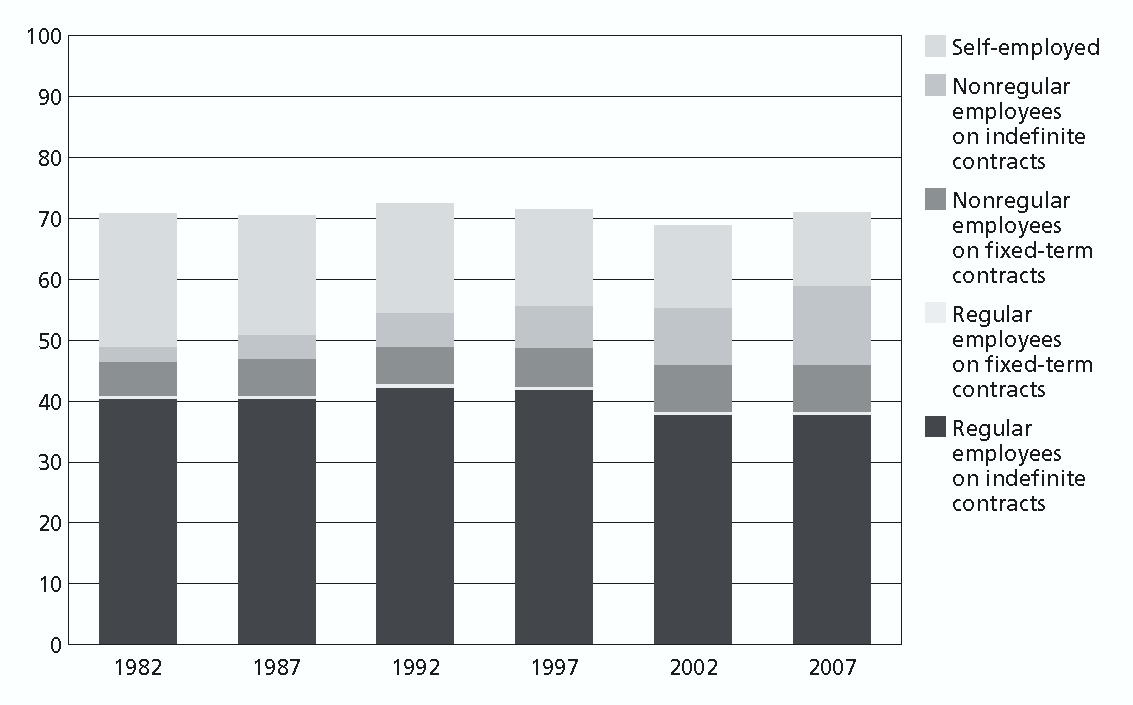
Of particular note here is the steady growth in the segment representing de facto nonstandard employees, even though they are working under indefinite contracts. This group has grown by 10.2 percentage points in the past 25 years, an increase consistent with the widespread perception regarding the increase in nonstandard employment. Yet the share occupied by standard employees (both on indefinite and fixed-term contracts) has declined by a mere 2.5 percentage points during the same time. Most of the increase in de facto nonstandard employment is balanced by a decrease in the share of the self-employed and others, which has declined by 9.7 points.
While the share of nonstandard employees on fixed-term contracts has also increased slightly (2.3 points), the overwhelming majority of nonstandard employees are now workers on indefinite employment contracts—that is, workers who are not titled as standard by their employers but do not qualify as such under Japanese labor law. Furthermore, the share of permanent nonstandard employees has increased fairly steadily since the early 1980s, suggesting that the overall increase in nonstandard employment in Japan has little connection with the relaxation of labor regulations in the mid- and late 1990s.
In our study, we anticipated the objection that individual industries are unlikely to mirror this neat inverse relationship between permanent nonstandard employees and the self-employed. Figure 7 plots the increase in the share of permanent nonstandard employees against the decrease in the share of the self-employed in each sector. The 45-degree blue line represents a linear correlation between the two variables. Most of the industries fall fairly close to the 45-degree line, indicating that the rise in permanent nonstandard employment has been accompanied by a comparable decline in self-employment.
The industries that diverge significantly from the line—those in which standard employment has declined significantly—are food manufacturing, communication, finance, and transportation, all sectors that have been the focus of major deregulation or privatization initiatives since the 1980s. For example, the 1980s saw the privatization of government monopolies in the food industry (Japan Tobacco and Salt), communications (Nippon Telegraph and Telephone), and transportation (Japanese National Railways). While most regular employees were retained, it is not surprising that their numbers should decline somewhat as a result of the privatization process. More noteworthy, perhaps, is the fact that such declines have not occurred in the retail sector and service industries that were subject to cost competition from the outset. This raises the interesting possibility that the basic reason for the glut of regular employees lies not with the labor market per se but with government regulation of the product market.
If, indeed, the decline in the number of workers in the self-employed sector accounts for the increase in nonstandard employees, then that increase may have hitherto unrecognized socioeconomic repercussions, as we point out in our 2013 paper. Labor conditions in the self-employed sector are known to be poor overall, and workers tend to miss out on such benefits as paid vacations and employer-sponsored health insurance. A shift from the self-employed category into the nonstandard employee category could signal an improvement in working conditions and such benefits as health-insurance coverage.
Figure 7. Change in Share of Nonstandard Permanent Employees and Self-Employed/Family Business Workers, 1982–2002.
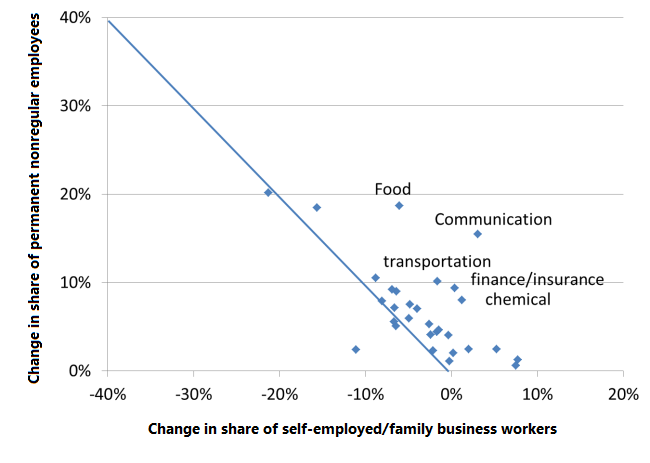
5. Trends in Seniority-Based Pay
The findings of our 2012 and 2013 papers suggest that, at least where long-term employment is concerned, the Japanese Employment System is alive and well, contrary to the popular perception. Can the same be said for the practice of linking pay to seniority? I tracked the gap between the average compensation of employees in their twenties and those in their fifties at the same workplaces using statistics published by the Ministry of Health, Labor, and Welfare. The results were surprising.
I began by compiling establishment-by-establishment data regarding wages levels for haenuki employees (those who entered the company upon graduation from a four-year university and continued working up to the time of the survey). For each workplace, I compared the average compensation for those in their twenties with those in their fifties and calculated the disparity, or the “seniority gap.” A larger seniority gap suggests a pay scale linked more tightly to seniority. I found considerable discrepancy in the seniority gap from workplace to workplace, and the distribution changed over time. In Figure 8, I track changes in the seniority gap in the lower, middle, and upper ranges of that distribution.
Figure 8. Change in Seniority Gap by Percentile, 1993–2010
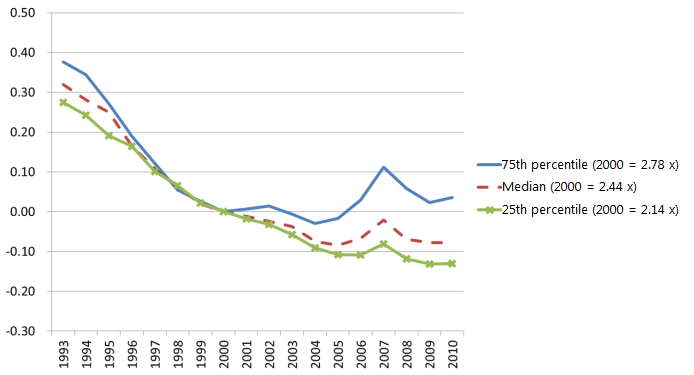

In 2000, the baseline year, the median seniority gap was 2.44. In the same year, the 75th percentile (midway between the median and the top of the range) was 2.78, and the 25th percentile (midway between the median and the bottom) was 2.14. This indicates a considerable spread among companies in terms of the magnitude of their seniority gap. Now, however, let us look at the trend. During the 1990s, the seniority gap declined for all three quantiles, indicating a decline in the average gap for all workplaces. After 2000, the gap continued to shrink among workplaces that began with the smallest gaps. But among those with the largest gaps, the trend of the 1990s reversed itself, and the gap began to grow again, suggesting a return to seniority-based pay. From about 2000 on, between one-fourth and one-half of Japanese companies reinforced the seniority curve in their pay scale.
So despite the perception of a gradual collapse of seniority-linked compensation, the shrinking seniority gap may actually be the result of companies temporarily adjusting their pay scales to compensate for the rise in their mandatory retirement ages since the 1990s—while keeping a lid on total personnel costs. If this is the case, then rumors of the death of a corporate culture that honors long-term employment and seniority-based wages may be premature.
6. The Tradition of Autonomous Labor-Management Relations
The foregoing analysis of key Japanese labor practices suggests that their reputed decline has been greatly exaggerated. Long-term employment, reliance on regular employees, and seniority-based pay—all key features of the Japanese Employment System—appear to be alive and well, at least in some parts of the Japanese labor market.
Why are these practices so persistent? The two papers referred to above do not offer a clear answer to this question, but my own studies and observations have led me to a tentative explanation. The first hint was our discovery that the workplace designation of an employee is a more important determinant of the employee’s treatment than the term of the employment contract. This highlights the importance of the distinction between “living law” and official or statutory law—a key concept in legal sociology—within the labor market.
In the Japanese labor market, living law in the form of customary practices may play a larger role in the formation of norms than statutory law. In fact, Japanese labor law itself provides for numerous exemptions in the name of labor-management autonomy. Moreover, the wave of deregulation that began in the 1980s actually expanded the role of collective agreements at the company level. Regulations governing work hours and overtime pay as well as those concerning employee dismissals all stress the importance of reaching an understanding between management and labor through consultation. In fact, one could argue that Japanese society lacks any effective mechanism of external control over management-labor relations at individual companies.
The economic rationality of Japanese employment practices stems primarily from the existence of an agreement between management and labor, and as long as the two sides are in accord, there may be no compelling reason to abandon traditional practices. So any attempt to make a dent in the “bedrock regulations” governing the labor market must keep in mind the key role labor-management agreements play in shaping and maintaining this purported “bedrock.”
References
Kambayashi, Ryo and Takao Kato. “Trends in Long-term Employment and Job Security in Japan and the United States: The Last Twenty-Five Years.” Center on Japanese Economy and Business Working Paper Series 302 (2012), Columbia University.
Kambayashi, Ryo and Takao Kato. “Good Jobs, Bad Jobs, and the Great Recession: Lessons from Japan’s Lost Decade.” PRIMCED Discussion Paper Series 41 (2013).

